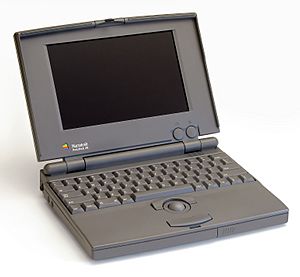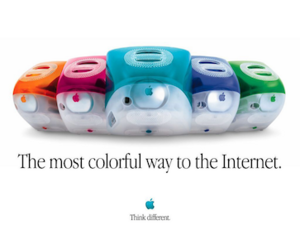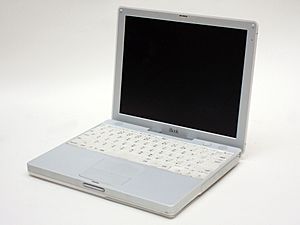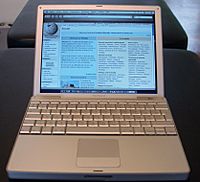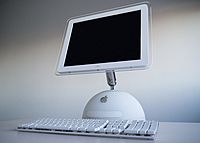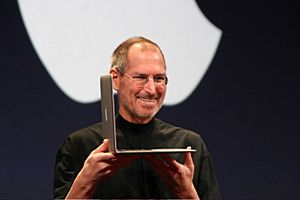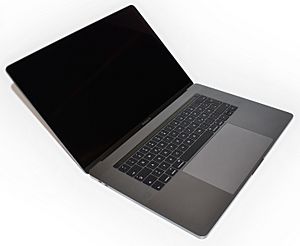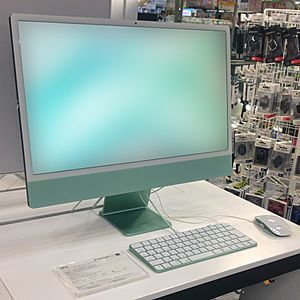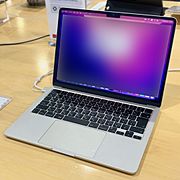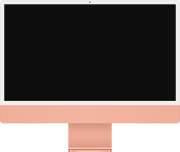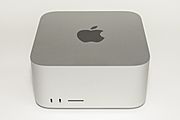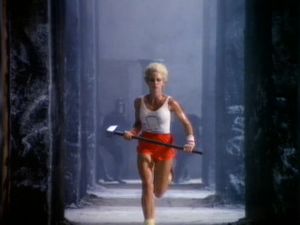Mac (computer) facts for kids
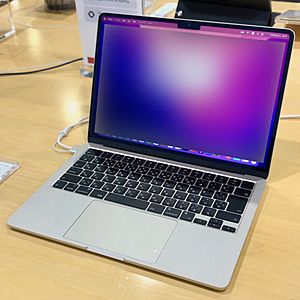
The Mac, short for Macintosh, is a family of personal computers made by Apple. This includes laptops like the MacBook Air and MacBook Pro. It also includes desktop computers such as the iMac, Mac Mini, Mac Studio, and Mac Pro. All Macs come with Apple's own operating system called macOS.
The first Mac was released in 1984. It was introduced with a very famous TV ad called "1984". After a good start, the Mac struggled in the 1990s. But things changed when Steve Jobs came back to Apple in 1996. Jobs helped create many successful products. He also launched the modern Mac OS X and moved Macs to Intel processors. Later, features from the iPhone were brought to the Mac. After Steve Jobs, Tim Cook became CEO. The Mac was updated again with new powerful models and a big change to Apple silicon chips. This made Macs use the same type of ARM processors as iPhones and iPads.
Contents
How the Mac Started
The First Macintosh (1979–1996)

In the late 1970s, the Apple II was a very popular computer. But then IBM released its own PC in 1981, which sold even more. Apple responded with the Apple Lisa in 1983. The Lisa had a new graphical user interface. This meant you could use a mouse to click on icons and drag things. You could also open programs by double-clicking. But the Lisa was very expensive, costing $9,995, and didn't have much software. So, it didn't sell well.
At the same time, a secret team at Apple was working on another computer. Jef Raskin started the Macintosh project in 1979. He wanted to create an affordable, easy-to-use computer for everyone. Raskin named it after his favorite type of apple, the McIntosh. Steve Jobs joined the team in 1981. Under Jobs, the Mac became more like the Lisa, with a mouse and a user-friendly screen. But it cost much less than the Lisa.
When the first Macintosh came out in 1984, people called it revolutionary. Sales started well but then slowed down. This was because the computer wasn't very powerful. It also only had one floppy disk drive, so users had to swap disks often. Many of the original Mac team members left Apple, including Jobs. He started a new company called NeXT.
Even with these issues, the first Macintosh gained many fans. Developers quickly made new programs for it. These included PageMaker and Excel. Apple soon released the 512K version with better performance. The Macintosh helped make the graphical user interface popular. It also came with many different fonts and text styles. This was new for computers at the time. It was the first WYSIWYG (What You See Is What You Get) computer. Thanks to PageMaker and Apple's LaserWriter printer, the Mac started the desktop publishing revolution. This made the Macintosh a big success.
In the late 1980s, Apple made the Mac more powerful. This was to attract tech fans and businesses. This led to the successful Macintosh II in 1989. However, Apple's first laptop, the Macintosh Portable, was too heavy and expensive.
Apple's CEO, John Sculley, didn't want to lower Mac prices. Macs were much more expensive than other computers. He also didn't want to let other companies make computers that ran Mac OS. This meant the Mac lost its chance to become the most common computer. But some Apple employees secretly worked on a cheaper Mac. In 1990, this led to the Macintosh LC and the Macintosh Classic. The Classic was the first Mac to cost under $1,000. Between 1984 and 1989, Apple sold one million Macs. In the next five years, they sold 10 million more.
In 1991, the Macintosh Portable was replaced by the smaller PowerBook 100. This was the first laptop with a palm rest and trackball in front of the keyboard. The PowerBook made a billion dollars in a year. By this time, Macs made up 10% to 15% of the computer market.
Apple then made a deal with IBM and Motorola to create new PowerPC processors. In 1992, Apple launched the Macintosh Performa line. This line had many similar models, which confused customers. Michael Spindler became CEO in 1993. He oversaw the Mac's move from Motorola 68K to PowerPC chips. The first PowerPC Mac, the Power Macintosh, was well-received.
Many new Macs had problems with quality. The 1995 PowerBook 5300 had many issues. Some even caught fire, leading to recalls. Apple was struggling financially. Its attempts to create a new Mac OS failed. Its computers were not keeping up with others. Sales dropped sharply. Companies switched to cheaper Windows NT computers. Even loyal Apple users saw no future for the Mac. Apple's market share fell from 9.4% in 1993 to 3.1% in 1997.
In 1996, Gil Amelio became CEO. He looked for a new operating system for Apple. He chose NeXTSTEP from Steve Jobs's company, NeXT. Apple bought NeXT on December 20, 1996. This brought Steve Jobs back to Apple.
Steve Jobs' Return (1997–2011)
NeXT had developed the NeXTSTEP operating system. It was good for multimedia and the internet. It was also popular with programmers. In January 1997, Steve Jobs showed off Rhapsody. This was a mix of NeXTSTEP and Mac OS. It would be Apple's new operating system. Jobs was only an advisor at first. But he became CEO after Amelio was fired in July 1997.
To fix the company, Jobs made Apple's operations simpler. He also cut jobs. He made a deal with Bill Gates of Microsoft. Microsoft agreed to make new versions of Office for Mac for five years. They also invested $150 million in Apple. In return, Apple made Internet Explorer the default Mac browser.
Jobs brought focus back to Apple. The Mac lineup was confusing. He simplified it into four main types: a laptop and a desktop for regular users, and a laptop and a desktop for professionals. Apple also stopped making some accessories. These changes helped Apple focus on making better products. Jobs also stopped letting other companies make Mac clones. This had cost Apple a lot of money.
Jobs made a deal with CompUSA, a big computer store. CompUSA would have a "store within a store" for Macs. This helped show off Macs and their software. Mac sales in these stores went from 3% to 14%. In November, the online Apple Store launched. This allowed customers to order custom Macs directly. When Tim Cook joined in 1998, he closed Apple's factories. He moved Mac production to Taiwan. This helped Apple save money and manage its inventory better.
Jobs' main goal was to "ship a great new product." The first was the iMac G3. This was an all-in-one computer designed to make the Internet easy to use. Most PCs were plain beige boxes. But Jony Ive gave the iMac a new, futuristic design. It was egg-shaped and made of clear plastic in a color called Bondi blue. It also had a handle on the back to make it seem friendly. Jobs decided the iMac would be "legacy-free." This meant it replaced old ports with new USB ports. He also removed the floppy disk drive and added a CD drive.
The iMac was shown in May 1998 and released in August. It was an instant success. It became the fastest-selling computer in Apple's history. 800,000 units were sold by the end of the year. Many iMac buyers had never used a computer before. The iMac helped the Mac become a trendsetter again. For several years, clear plastic became popular in many products.
Apple knew it couldn't beat Windows in the business market. So, it focused on design and ease of use for regular people and even teens. Apple also changed how it developed products. Design became very important from the start. Jony Ive and Jobs would first decide on a product's "soul." Then, marketing, engineering, and operations teams would work together.
The next two Mac products in 1999 were the Power Mac G3 and the iBook. They also had colorful, clear plastic designs. The iBook was the first laptop with built-in Wi-Fi. It was the best-selling laptop in the U.S. in late 1999. The professional Titanium PowerBook G4 came out in 2001. It was the lightest and thinnest laptop in its class. It was also the first laptop with a wide screen.
The design of consumer Macs changed again in 2001. They went from colorful plastics to white plastic. This was seen in the Dual USB "Ice" iBook. This iBook was designed to be more durable.
Apple was also working on a new operating system to replace the old Mac OS. This new system, called Rhapsody, used a Unix base. Apple made the core of Rhapsody open source as Darwin. Apple also created Carbon, which helped developers update their old Mac apps for the new system. Mac OS X was shown in January 2000. It had a new look called Aqua. It was also much more stable. The first version of Mac OS X, version 10.0 Cheetah, was released in March 2001.
In 1999, Apple decided the Mac would be a "digital hub." This meant it would be the center of a user's digital life. Apple made several software apps for Mac users. The iMac DV gained FireWire in 1999. This allowed users to connect camcorders and make movies with iMovie. The iMac also got CD burning features. With the iTunes app, users could copy CDs, make playlists, and burn them to blank discs. Other apps included iPhoto for photos and GarageBand for music.
Apple's digital hub idea led the company into other markets. This included the iTunes Store, iPod, iPhone, and iPad. In 2007, Apple changed its name from Apple Computer Inc to Apple Inc. By 2007, the iPod made up half of Apple's income.
Apple kept releasing new Mac models. This included the white "Sunflower" iMac G4. Its screen could swivel around easily. In 2003, Apple released the aluminum PowerBook G4. Apple also replaced Internet Explorer with its new browser, Safari. The first Mac Mini was an affordable desktop computer. It was introduced in 2005, along with the iWork office suite.
Macs Switch to Intel and iPhone Features
In 2005, Steve Jobs announced a big change. All Macs would switch from PowerPC to Intel processors. He said Mac OS X had been ready for both types of chips since 2000. Users could still run old PowerPC apps using Rosetta. They could even run Windows using Boot Camp. This change helped Mac sales grow for several years.
After the iPhone came out in 2007, Apple started bringing iPhone features to the Mac. These included multi-touch gestures, instant wake-up from sleep, and fast flash storage. In 2008, Jobs showed the first MacBook Air. He pulled it out of a manila envelope to show how thin it was. The MacBook Air focused on wireless connections instead of many physical ports. It didn't have a FireWire port, a CD/DVD drive, or a replaceable battery. Users could access discs from other computers on their network. Many years later, people said the MacBook Air "immediately changed the future of laptops."
OS X Lion added new software features from the iPad. These included FaceTime, full-screen apps, and a Mac App Store for online downloads. It also supported Retina displays, which first came with the iPhone 4. iPhone-like multi-touch was added to all MacBook trackpads. It also came to desktop Macs with the Magic Mouse and Magic Trackpad. The 2010 MacBook Air added an iPad-like standby mode and flash memory for storage.
Apple also made its Macs more environmentally friendly. The 2008 MacBook Air was free of toxic chemicals. Its packaging was also smaller. The iMac and MacBook Pro were redesigned with more recyclable materials like aluminum and glass.
In 2011, the MacBook Pro was the first computer to support Intel's new Thunderbolt connector. This allowed very fast data transfer.
Macs Today (2012–Present)
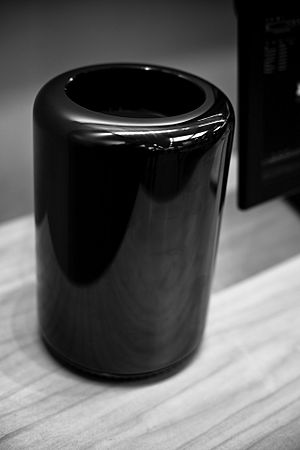
Steve Jobs resigned as CEO in August 2011 due to health issues. Tim Cook became his successor. Cook's first big announcement was iCloud. This moved the "digital hub" from the Mac to the cloud. In 2012, the MacBook Pro got a Retina display. The iMac became thinner and lost its CD/DVD drive.
In 2013, Apple introduced a new cylindrical Mac Pro. It had a small, dark gray cylindrical body. Its parts were arranged around a central cooling system. Reviewers liked its power and futuristic design. However, professional users didn't like it. They said it was hard to upgrade and lacked expansion slots.
The iMac was updated with a 5K Retina display in 2014. This made it the highest-resolution all-in-one desktop computer at the time. The MacBook was brought back in 2015. It had a new aluminum body, a 12-inch Retina display, and a fanless processor. It also had a new Butterfly keyboard and a single USB-C port. It was praised for being portable. But it was criticized for its low performance and needing adapters for most USB devices. It also had a high starting price.
Focus on Professionals
The Touch Bar MacBook Pro was released in October 2016. It was the thinnest MacBook Pro ever. It replaced all ports with four Thunderbolt 3 (USB-C) ports. It also had a thinner "Butterfly" keyboard. This keyboard replaced the regular function keys with a Touch Bar. Many users didn't like the Touch Bar. They also found it annoying to buy dongles for their old USB devices.
A few months after its release, users reported problems with the Butterfly keyboard. Keys would get stuck or skip letters. This was often caused by dust or crumbs getting under the keys. Since the keyboard was built into the laptop, it was hard to fix. Apple later settled a $50 million lawsuit over these keyboards. These models also had a problem called "flexgate." The display cable was too short and could get damaged when opening and closing the laptop.
Many people felt Apple was no longer focusing on professional users. This was due to the keyboard issues, Apple stopping its professional photography app, and no updates to the Mac Pro. In 2017, Apple admitted the 2013 Mac Pro didn't meet expectations. They said they had designed it into a "thermal corner," which stopped them from making a planned update. Apple then announced plans for an iMac Pro and a new, expandable Mac Pro. The iMac Pro was shown in 2017. It had updated Intel Xeon W processors and Radeon Pro Vega graphics.
In 2018, Apple released a redesigned MacBook Air. It had a Retina display, Butterfly keyboard, and Thunderbolt 3 USB-C ports. The Butterfly keyboard was updated three times. But many users still had reliability issues. Apple launched a program to repair affected keyboards for free. Some 2018 MacBook Pros with the Core i9 processor also got too hot. This caused them to slow down. Apple released an update to fix this.
The 2019 16-inch MacBook Pro and 2020 MacBook Air replaced the Butterfly keyboard. They used a more reliable scissor-switch Magic Keyboard. The Touch Bar and Touch ID became standard on MacBook Pros. The Esc key was also brought back as a physical key. In 2019, Apple showed a new Mac Pro. It had a larger case that allowed for hardware upgrades. It also had a new expansion system. Almost every part of the new Mac Pro can be replaced by the user. It received good reviews for its power, modularity, and quiet cooling.
Apple Silicon Chips
In April 2018, news reports said Apple planned to replace Intel chips with ARM processors. These are similar to those used in iPhones. This caused Intel's stock to drop. Many felt this made sense because Intel chips weren't improving much. They also couldn't match ARM chips for battery life.
In 2020, Tim Cook announced that Macs would switch to Apple silicon chips. These chips are based on the ARM design. This change would happen over two years. Apple also introduced Rosetta 2. This allows Apple silicon Macs to run apps made for Intel chips. On November 10, 2020, Apple announced its first chip for the Mac, the Apple M1. They also showed new Macs that would use the M1 chip. These included the MacBook Air, Mac Mini, and the 13-inch MacBook Pro. These new Macs received very positive reviews. People highlighted big improvements in battery life, performance, and how well they managed heat.
The iMac Pro was quietly stopped in March 2021. On April 20, 2021, a new 24-inch iMac was shown. It had the M1 chip, seven new colors, and was made from recycled aluminum. On October 18, 2021, Apple announced new 14-inch and 16-inch MacBook Pros. These had a new mini-LED display. They also brought back the MagSafe charging port, HDMI port, and SD card slot.
On March 8, 2022, the Mac Studio was shown. It had more powerful M1 Max and M1 Ultra chips. It looked similar to the Mac Mini. It got very good reviews for its flexibility and many ports. Its performance was "impressive." It even beat the most powerful Mac Pro with an Intel chip. It was also more power-efficient and smaller. The Mac Studio was meant to replace the 27-inch iMac, which was stopped on the same day. In 2022, Apple announced an updated MacBook Air with a new M2 chip. It had a flat design, full-sized function keys, MagSafe charging, and a Liquid Retina display.
The Mac Pro with the M2 Ultra chip was shown in 2023. The Intel-based Mac Pro was stopped on the same day. This completed the move of all Macs to Apple silicon chips.
What Macs Are Available?
- Overview of Mac lineup
-
MacBook Air, a light laptop for everyday use.
-
MacBook Pro, a powerful laptop for professional work.
-
iMac, an all-in-one desktop computer.
-
Mac Mini, a small desktop computer for starting out.
-
Mac Pro, a powerful desktop tower that can be upgraded.
| Release date | Model | Processor |
|---|---|---|
| November 10, 2020 | MacBook Air (M1, 2020) | Apple M1 |
| April 30, 2021 | iMac (24-inch, M1, 2021) | |
| June 24, 2022 | MacBook Pro (13-inch, M2, 2022) | Apple M2 |
| July 15, 2022 | MacBook Air (13-inch, M2, 2022) | |
| January 24, 2023 | Mac Mini (2023) | Apple M2 or M2 Pro |
| MacBook Pro (14-inch, 2023) | Apple M2 Pro or M2 Max | |
| MacBook Pro (16-inch, 2023) | ||
| June 13, 2023 | MacBook Air (15-inch, M2, 2023) | Apple M2 |
| Mac Studio (2023) | Apple M2 Max or M2 Ultra | |
| Mac Pro (2023) | Apple M2 Ultra |
How Macs Are Advertised
The first Macintosh was advertised during the Super Bowl XVIII with the famous "1984" ad. This ad was directed by Ridley Scott. It hinted at George Orwell's book Nineteen Eighty-Four. The ad showed Apple wanting to "rescue" people from the big computer company IBM. This ad is now seen as a "masterpiece." Before the Mac, computer ads were for tech experts. But the Mac launch changed this. Apple created excitement around the product.
Apple's brand is known for connecting with customers. This is a key reason for the Mac's success. After Steve Jobs returned, he launched the Think different ad campaign. This campaign showed the Mac as the best computer for "creative people." It featured black-and-white photos of famous people like Albert Einstein and Martin Luther King Jr.. Jobs said, "if they ever used a computer, it would have been a Mac." This ad campaign won many awards. In the 2000s, Apple continued with successful campaigns like Switch and Get a Mac.
Apple focuses on design and quality. This has made the Mac a high-end, premium brand. Apple's computers have unique and appealing designs. This helps them stand out. Apple often uses product placement in movies and TV shows. You can see Macs in Mission: Impossible and Sex and the City. Apple is known for not showing villains using Apple products.
Macs are known for having very loyal customers. In 2022, the Mac had the highest customer satisfaction score among personal computers. As of that year, Apple was the fourth largest seller of personal computers.
Mac Parts (Hardware)
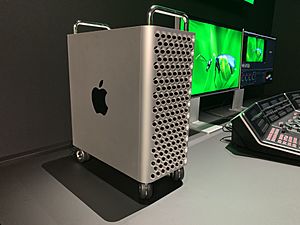
Apple works with Asian manufacturers like Foxconn to make its hardware. Apple designs its own operating system and chips. This allows them to control every part of their products. It also helps the hardware and software work together very well.
All Macs currently being made use ARM-based Apple silicon processors. These Macs are praised for their performance and power efficiency. They can run Intel apps using the Rosetta 2 translation layer. They can also run iOS and iPadOS apps from the App Store. These Macs have fast Thunderbolt 4 or USB 4 connections. Apple silicon Macs have their own integrated graphics instead of separate graphics cards. MacBooks charge with either USB-C or MagSafe connectors.
Apple also sells accessories for the Mac. These include the Studio Display and Pro Display XDR monitors. They also sell AirPods wireless headphones. And they make keyboards and mice like the Magic Keyboard and Magic Mouse.
Mac Software
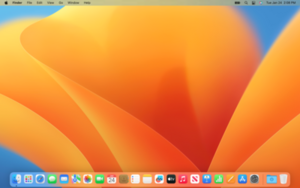
Macs run the macOS operating system. It is the second most used desktop OS in the world. Macs can also run Windows, Linux, or other operating systems. This can be done using special software or by installing them side-by-side.
macOS is the newer version of the classic Mac OS. The classic Mac OS had nine versions between 1984 and 1999. The last classic version, Mac OS 9, came out in 1999. It is still remembered fondly by some users. Mac OS 9 was replaced by Mac OS X in 2001. Over the years, Mac OS X was renamed to OS X and then to macOS.
macOS is based on NextSTEP and FreeBSD. It uses the XNU kernel. The core of macOS is open-source as the Darwin operating system. macOS has a user interface called Aqua. It also has tools for programmers called Cocoa. The main programming languages are Objective-C and Swift. Macs work very well with other Apple devices like iPhones and iPads. This is thanks to Continuity features like Handoff and Sidecar.
The first version of Mac OS X, version 10.0, was released in March 2001. Later versions added many new features. 10.4 Tiger added Spotlight search. 10.7 Lion brought many iPad-inspired features. 10.10 Yosemite completely changed the look of the user interface. 10.12 Sierra added the Siri voice assistant. 10.14 Mojave added a dark mode. 10.15 Catalina stopped supporting older 32-bit apps. 11 Big Sur brought an iPhone-like redesign. 13 Ventura added Stage Manager and Continuity Camera.
The Mac has many apps available. These include popular apps like Google Chrome, Microsoft Office, and Adobe Creative Cloud. Apple has also made its own apps for the Mac. These include Final Cut Pro for video, Logic Pro for music, and iWork for documents. Many open-source software apps also run on macOS. These include LibreOffice, VLC, and GIMP. Apple's official tool for making apps is Xcode. This lets developers create apps for Macs and other Apple devices.
The latest version of macOS is macOS 13 Ventura. It was released on October 24, 2022.
Timeline
| Timeline of Mac model families |
|---|
 |
Source: Glen Sanford, Apple History, apple-history.com
See also
 In Spanish: Macintosh para niños
In Spanish: Macintosh para niños


